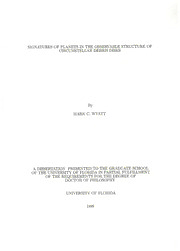Table Of ContentSIGNATURESOFPLANETSINTHEOBSERVABLESTRUCTUREOF
CIRCUMSTELLARDEBRISDISKS
By
MARKC.WYATT
ADISSERTATION PRESENTEDTOTHEGRADUATESCHOOL
OFTHEUNIVERSITYOFFLORIDAINPARTIALFULFILLMENT
OFTHEREQUIREMENTSFORTHEDEGREEOF
DOCTOROFPHILOSOPHY
UNIVERSITYOFFLORIDA
1999
ACKNOWLEDGMENTS
ThefirstpersonIwouldliketoacknowledgeismysupervisor,StanDermott,
notonlyforhisadvice,encouragement,andinfluenceonmywork,butalsoforenticing
—
meovertoFloridainthefirstplace ithasbeenatremendousexperience. EquallyI
wouldliketothankmysupervisoratQueenMaryandWestfieldCollege,CarlMurray,
forinspiringmetocontinuewithacareerinAstronomy. Thanksarealsoduetothe
FulbrightcommissionforsupportingmeinmyfirstyearinFlorida.
ThisdissertationisessentiallyanextensionoftheworkthatStanDermottand
hisSolarSystemDynamicsgrouphaveaccomplishedoverthepast15orsoyearsin
theireffortstomodelthezodiacalcloud. Itisfairtosaythatthisdissertationcould
nothavebeenachievedwithoutthisfoundation. Iwishtothankallmembersofthe
group,pastandpresent,especiallyKeithGrogan,forcountlessusefuldiscussions.
AnotherpersontowhomIamindebtedisCharlieTelesco,bothforhisdirect
inputtothedissertationthroughourworkontheHR4796disk,andforproviding
mewiththeopportunitytogoobservingwithhisInfraredAstrophysicsgroup. The
perspectiveIgainedfromthisobservingexperiencehasbeenanessentialpartofmy
Ph.D. education. IacknowledgeallofthemembersoftheOSCIRobservingteam,
especiallyRobertPinaandScottFisher,fortakingthetimetoteachmetheobserving
lore.
Onapersonallevel,Iwouldliketothankmyparentsfornourishingthegift
oflifeinme. Mostofall,Iwanttothankmyfiancee, Maxine, withwhomIhave
u
sharedthelast8years,andwhoseloveandsupportthroughoutIcouldnothavelived
without. Thisdissertationisdedicatedtoher.
TABLEOFCONTENTS
page
ACKNOWLEDGMENTS
ii
ABSTRACT vii
CHAPTERS
1 INTRODUCTION 1
1.1 Motivation 1
1.2 TheSearchforExtrasolarPlanets 2
1.3 ParadigmofStarFormation 4
1.4 ParadigmofPlanetaryFormation 7
1.5 CircumstellarDebrisDisks 10
1.6 TheZodiacalCloud 15
1.7 AimsandOutline 19
2 DISSECTIONOFACIRCUMSTELLARDISKOBSERVATION ... 21
2.1 DiskParticleThermalEmission 21
2.2 DiskStructureDefinition 22
2.3 LineofSightBrightness 23
2.4 ObservingProcedure: RealImages 24
2.5 ModelingDiskImages 26
3 THESTRUCTUREOFADYNAMICDEBRISDISK 28
3.1 Gravity 29
3.2 Collisions 31
3.2.1 CollisionalCascade 31
3.2.2 CollisionalLifetime 32
3.2.3 EvidencefromtheZodiacalCloud 36
3.3 RadiationForces,(3 38
3.3.1 RadiationPressure 38
3.3.2 Poynting-Robertson(P-R)LightDrag 42
3.3.3 EvidencefromtheZodiacalCloud 47
3.4 DiskParticleCategories 49
3.4.1 CategoryDefinitions 49
3.4.2 CategoryCross-SectionalArea 51
3.5 DebrisDiskEvolution 53
3.6 ThePerturbedDynamicDisk 56
IV
4 SIGNATURESOFPLANETARYPERTURBATIONS 57
4.1 SecularPerturbations 58
4.1.1 PerturbationEquations 58
4.1.2 SolutiontoPerturbationEquations 60
4.1.3 OffsetandPlaneofSymmetryofFamilyMaterial .... 64
4.1.4 OffsetandWarpofWholeDisk 70
4.1.5 PhysicalUnderstandingofOffsetandWarp 71
4.1.6 ObservationalEvidenceofOffsetandWarpintheZodiacal
Cloud 72
4.2 ResonantPerturbations 75
4.2.1 ResonantTrappingduetoParticleMigration 76
4.2.2 ResonantTrappingduetoPlanetaryMigration 81
4.2.3 ResonanceRemovalMechanisms 84
4.3 Accretion 85
5 DISKPARTICLEOPTICALPROPERTIES 87
5.1 InterstellarDustGrains 88
5.2 PrimordialCometaryGrains 90
5.3 ZodiacalDust 92
5.4 DebrisDiskDust 93
5.5 DustModels 94
6 HR4796LITERATUREREVIEW 99
6.1 ThestarsHR4796AandHR4796B 99
6.2 ThePre-discoveryDisk 104
6.3 DiskDiscoveryImages 106
6.4 ThePost-discoveryDisk 109
7 THEDYNAMICHR4796DISKMODEL 113
7.1 ModelofOffsetDiskStructure,a(r,9,0) 113
7.1.1 DistributionofOrbitalElements,a(a,e,I,Q,0) 114
7.1.2 ConversiontoSpatialDistribution,o(r,6,<j>) 116
7.2 ModelofP(A,r) 118
7.2.1 OpticalPropertiesofDiskParticles 118
7.2.2 Cross-sectionalAreaDistribution 121
7.2.3 PericenterGlow 124
7.3 DiskModelOrientation 124
7.4 ModelingProcessandResults 125
7.4.1 SymmetricalDiskStructure 127
7.4.2 ParticleSize 127
7.4.3 AsymmetricalDiskStructure 129
7.4.4 StatisticalSignificance 131
8 INTERPRETATIONOFTHEDYNAMICHR4796DISKMODEL . 132
8.1 TheDynamicHR4796Disk 132
8.1.1 RadiationForces,/3 132
8.1.2 CollisionalProcesses 134
8.1.3 P-RDrag 135
8.1.4 TheDynamicHR4796Disk 136
v
8.2 InterpretationofLobeAsymmetry: HR4796’sSecularPerturbations137
8.2.1 JustHR4796B 140
8.2.2 HR4796BandaPlanet 140
8.2.3 JustPlanet 141
8.2.4 OtherConsiderations 142
8.3 DiscussionofEmittingParticleCategory 142
8.4 OriginoftheInnerHole 149
8.5 InterpretationoftheResidualStructure 151
9 CONCLUSION 153
9.1 Conclusion 153
9.2 FurtherWork 157
9.2.1 HR4796 157
9.2.2 OtherDisks 159
REFERENCES 161
BIOGRAPHICALSKETCH 169
vi
AbstractofDissertation PresentedtotheGraduateSchool
oftheUniversityofFloridainPartialFulfillmentofthe
RequirementsfortheDegreeofDoctorofPhilosophy
SIGNATURESOFPLANETSINTHEOBSERVABLESTRUCTUREOF
CIRCUMSTELLARDEBRISDISKS
By
MarkC.Wyatt
December 1999
Chairman: StanleyF.Dermott
MajorDepartment: Astronomy
Recentadvancesinastronomicalinstrumentationhaveledtoavastincrease
inourknowledgeoftheenvironmentsofnearbystars. Inparticular,wearenowable
toimagethethermalemissionfromthedisksofdustaround mainsequencestars
thatmaybethefossilremnantsofplanetaryformation. Theseobservationsimply
thatthedistributionofdustinthedebrisdisksisneithersmoothnorsymmetrical;
e.g.,mid-infraredimagesofthediskofdustaroundtheyoungAOVstarHR4796A
showtwolobesofemission,oneofwhichmaybe~5%brighterthantheother. The
observedstructureofthedebrisdiskinthesolarsystem,i.e.,thezodiacalcloud,also
containsasymmetries: ithasanoffsetcenterofsymmetry, itiswarped, andthere
isanasymmetricringofdustco-orbitingwiththeEarth. Sincethezodiacalcloud’s
asymmetrieshavebeenshowntobesignaturesofthegravitationalperturbationsof
thesolarsystem’splanets, itishopedthatitmaybepossibletoindirectlydetect
extrasolarplanetarysystemsbytheirsignaturesindebrisdiskobservations.
Thisdissertationusesthephysicalprocessesthataffecttheevolutionofde-
brismaterialinthesolarsystemtocreateageneralizedmodelfortheevolutionof
circumstellardebrismaterial. Itthenshowshowplanetaryperturbationsaffectthat
evolution,therebycausingthesignaturesofplanetsseeninthestructureofthezodi-
acalcloud. Thismodelcanbeusedtoprovideaquantitativeinterpretationofdebris
diskobservations,andthenecessarymodelingtechniquesaredemonstratedbytheir
applicationtoobservationsoftheHR4796disk. Aswellasdeterminingthelarge
scalestructureoftheHR4796disk,themodelingshowshowasmallbody(>10M®)
intheHR4796systemthatisonanorbitwithaneccentricitylargerthan0.02could
bethecauseoftheobservedbrightnessasymmetry. Themodelingalsoshowsthat
thedisk’smid-IRemittingparticlesarehotterthanblackbody(andthereforesmall),
anddiscusseswhethertheyareintheprocessofbeingblownoutofthesystemby
radiationpressure.
viii
CHAPTER
1
INTRODUCTION
1.1 Motivation
Oneofthemostconsistenthumanendeavorssincethedawnoftimehasbeento
understandthenatureoftheuniverseinwhichwelive.Weareconstantlyquestioning
howtheuniverse, andespeciallylifeonEarth,cametobeasitis. Essentiallythis
isasearchforanunderstandingofourplaceintheuniverse,whichinevitablyleads
ustoponderwhetherlifecouldexistelsewhereinthecosmos. Eversincethemiddle
ofthe sixteenth century when the Copernican heliocentric model ofthe universe
superseded thegeocentricview, thissearchhasbeenahumblingexperience aswe
begintograspthegargantuanscaleoftheuniverse. Theobservationaldataobtained
overtheprevious450yearspaintsapictureoftheuniverseasweseeittodaythat
—
placestheEarthinafarmoreinsignificantrolethanwaspreviouslyimagined we
nowknowthatnotonlyistheEarthnotthecenteroftheuniverse, butneitheris
theSun,sinceitisjustoneofanestimated400billionstarsthatmakeuptheMilky
Way,whichisitselfjustonegalaxyoutofatleast~80billionothersintheuniverse.
Howevermuchwehavelearnedaboutthenatureoftheuniverse,thesearch
forlifeoutsidetheconfines ofthe Earth has so farproved fruitless. Even in the
corneroftheuniverseaboutwhichwehavethemostinformation,thesolarsystem,
thedebatecontinuesastowhetherthereis (orindeedhasbeen) lifeinsomeform
oranotheronMars. TheoceanunderthefrozenicesofJupiter’smoonEuropaand
thesurfaceofSaturn’smoonTitanalsoprovidepotentialhabitatsforlifeinthesolar
system, possibilitiesthatremaintobetested. However, thesolarsystemisbut a
smallportionoftheuniverse. Sincestarsaresupposedtohaveformedinthesame
1
2
mannerastheSun,andthesolarsystem’splanetsarethoughttobeabyproductof
thatformationprocess,thishasledustospeculatethatsomeoftheO(1022)starsin
theuniversecouldalsohaveplanetsorbitingthem,someofwhichmay(past,present,
orfuture)harborlife. Thus,ithasbeenoneoftheholygrailsofrecentastronomy
tofindhabitableplanets(i.e.,onesthatcouldpotentiallysupportlife)orbitingstars
otherthantheSun.
1.2 TheSearchforExtrasolarPlanets
Fromanobservationalpointofview,thedirectdetectionofhabitableplanets
aroundeventhecloseststarsisbeyondourcurrenttechnologicalcapabilities(Back-
man1998;Woolf&Angel1998). Therearetworeasonsforthis. First,technological
constraintsmeanthatuntilrecentlytelescopesdidnothavetheresolvingpowertosee
theregionsaroundthestarswhereitwasexpectedthatplanetswouldhaveformed.
Evennow,theregionsclosetothestar(~1AU)whereweanticipatethatterrestrial
planetswouldformareobscuredfromviewbythediffractionhaloofthestellarimage.
Second,planetsbydefinitiondonothaveaninternalsourceofenergy,whichmeans
—
thattheyarenotverybright anylightobservedfromthemiseitherreflectedor
reprocessedstarlight. Thus,planetsarefardimmerthanthephotosphericemission
fromstaraboutwhichtheyareorbitingandaretoodimtobedetecteddirectlyat
present(Woolf&Angel1998).
Thisledtothedevelopmentofsomeingenioustechniquestoindirectlydetect
thepresenceofplanetsaroundstars. Themostproductiveofthesetechniquesuses
the gravitationaleffect ofaplanetarysystem onthepositionofastar relativeto
thebarycenterofthestar/planetsystem. Thiscausesawobbleinthemotionofthe
starrelativetothe Sun. Thiswobblecanbedetected inthreeways: astrometric
detection,bymeasuringthechangeinpositionofastaronthesky(e.g.,Gatewood
1987); dopplershiftdetection, bymeasuringthevariationintheradialvelocityof
star(e.g.,Mayor&Queloz1995;Marcy&Butler1998);bymeasuringvariationsin

